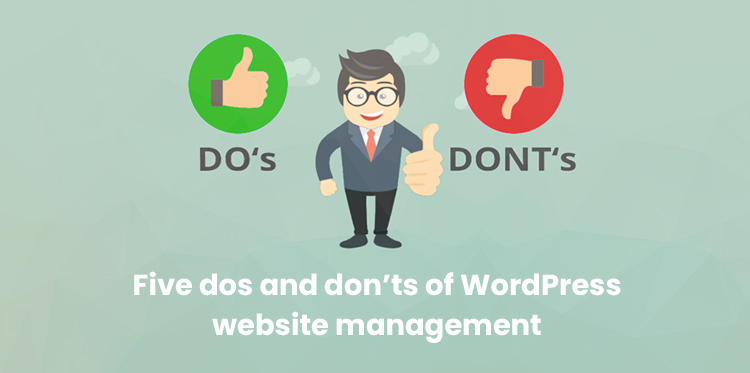What is WordPress Website Management?
If you’re running a WordPress website, you may already know the basics of WordPress such as posting blogs, adding plugins, and even web designing a little.
Table of Contents
Do these fall under WordPress website management? It is easy to misunderstand website management because its boundaries are fuzzy and subjective.
Let’s assume you’re a website manager at a small company and there’s no one else doing basic site maintenance tasks.
All the tasks related to the website, in this case, are likely to be done by you. From publishing posts to optimizing performance and maintaining site security, every management task falls under this domain.
In a bigger company, each of these tasks would fall to different teams and individuals. So the tasks associated with website management can vary. If you have a WordPress website, you have to manage it properly to make sure it runs smoothly.
The following dos and don’ts highlight the essentials of WordPress website management.
1. DO – Choose plugins for essential functionality
One of the most powerful parts of WordPress is its plugin library. Using plugins, you can add more functionality to your website and customize it to your liking.
While plugins can help you add endless features to your website, they also make it slow. Too many plugins also increase the possibility of plugin and theme conflicts, thus creating the chances of downtime.
The solution is to use a set of trusted plugins that are coded well. Badly-coded plugins might make too many database requests, or clog up your site’s bandwidth.
It is thus vital to select plugins that are reliable and don’t eat into the performance of your website. Do not install plugins that only have a few installs and are reviewed poorly on WordPress.
2. DON’T – Use a locked theme
We all love WordPress themes. They enable site owners to quickly design their website from scratch. A well-built theme takes the guesswork out of web design and allows site owners to focus on growing traffic.
There are endless themes you can choose from while setting up your website. The basic idea is to avoid using a locked theme.
What exactly is a locked theme?
Many themes come with in-built features to design a website from scratch. These themes allow users to design your website from scratch, and the design tools available are built into the theme.
Website owners are then free to build their entire website using the tools and extensions made available by the theme. This first appears like a good option but can be a big roadblock down the road.
How?
Let’s assume you purchase a theme loaded with tons of design options. You set up your entire website design using the theme. After a month or two, you have a change of mind and decide to change the theme.
Maybe the theme is too heavy or limits your options when it comes to SEO and performance optimization. Since this is WordPress, you should be able to change your theme with a click of a button, right?
Wrong. Since every aspect of your web design is configured through the theme, changing it would require a ground-up rebuild. Unless you’re willing to spend another 2-3 weeks building a new website, you’re stuck.
This is what locked themes do. They essentially tie you down to one theme and severely limit your options. In case the theme you choose stops releasing updates for popular plugins, and the theme company goes defunct, you’re stuck in limbo.
You should instead choose themes that are simple and don’t come with loaded design tools. These themes can be changed instantly, and don’t require a massive rebuild. Themes like Astra, SKT Themes, and more are examples of the same.
3. DO – Explore web security and create a security infrastructure
What do you do if your website one day redirects to a fishy pharmaceutical page?
This scenario sounds bleak and unlikely, but it happens. 83% of all CMS websites hacked are built with WordPress.
What happens if one day your site is hacked? As the website manager, do you have a list of troubleshooting steps to diagnose and fix the website?
Ideally, you should not be googling ‘how to fix a hacked WordPress website’ after your site has already been hacked. You should have the ready infrastructure to avoid attacks, and in case they happen, mitigate and eliminate the issue.
So how do you go about creating a secure WordPress website? As a start, it can’t hurt to know a little bit about WordPress security. You should take a look at manuals and guides on how to fix common site errors like internal server error 500, database error, WSOD, permissions error, and so on.
Most WordPress attacks are malware-based. You should thus know how to clean malware from a WordPress website as well. There are ample user manuals available that explain how you can do this.
The following steps highlight how you can secure your WordPress site:
- Install a security plugin:
- Change wp-admin URL:
- Add 2FA:
- Website backups:
WordFence and iThemes are popular security plugins that enable you to create a basic security infrastructure for your site. These plugins enable you to scan your website for malware, block malicious IPs, set up a security firewall, and much more.
Many brute-force attacks take place because hackers know the login page of every WordPress website. These can be avoided if you simply change your website’s login URL
Two-factor authentication is another way to thwart brute force attacks.
Keeping regular website backups is a great way to safeguard your website. Anytime your website is down or facing malware issues, you can simply reinitialize a backup and resolve the entire issue instantly. Later, you can quarantine the infected version and identify the vulnerabilities causing the attacks to happen.
4. DON’T – Use nulled plugins and themes
Premium plugins and themes often promise attractive and promising features. In some cases, these features may tempt website owners enough to download and install pirated versions of premium plugins and themes.
This is a dangerous practice for many reasons. First, it is illegal to use pirated versions of proprietary software. You can face legal action by using nulled versions of certain plugins and themes.
Keeping the legal ramifications aside, it is not a good choice security-wise. Nulled plugins and themes are often a gateway for malicious malware. It is always better to either pay for the functionality you’d like or find another way to implement it.
Using a nulled plugin is akin to stealing, and the last thing a growing website needs is a legal cloud.
5. DO – Consider building an app for your WordPress website management
App development is hard, right?
Imagine writing code to create a brand new app from scratch. If you don’t have a dev team to do it, you’d need to hire an agency to build an app for your website, right?
Not really. There are several ways to make an app for your WordPress website, even if you don’t know any programming languages.
AppMySite is an example of one such platform and enables you to make free mobile apps on a costless subscription plan. Once you’re ready to go live, you can upgrade and publish the apps to the app stores.
The great thing about such a tool is that it automatically syncs your website content to the app. This means that any changes you make to the content of your site will be synced to the app.
In essence, you can manage your app by simply maintaining your website.
In conclusion
A poorly managed website is slow, prone to cyber attacks, and all-in-all unreliable for both site owners and visitors.
As a website owner, you need to have a firm grip over how your website is managed. A website with security concerns can easily tarnish the brand associated with it.
The points mentioned here provide a vital intro to the world of WordPress management. By imbibing the steps mentioned here, you can set foot in the right direction and maintain your site properly.


